And I also recently found one containing a dead shrew.
But in my case it was an old coke bottle buried in oak woodland leaf litter, and the only remaining evidence of the shrew was a skull and an encrusting of invert exoskeletons (last meals).
And by old, I mean maybe 50-ish years. For the bottle is an 8oz "hobbleskirt" from the Coca-Cola Bottling plant in Hayward, California. And that plant closed in the early 1960s.
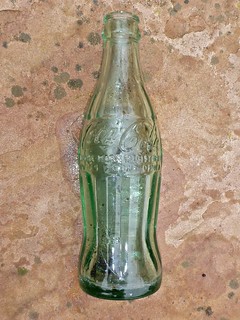

For being so small and fragile, the shrew skull is in pretty good shape:
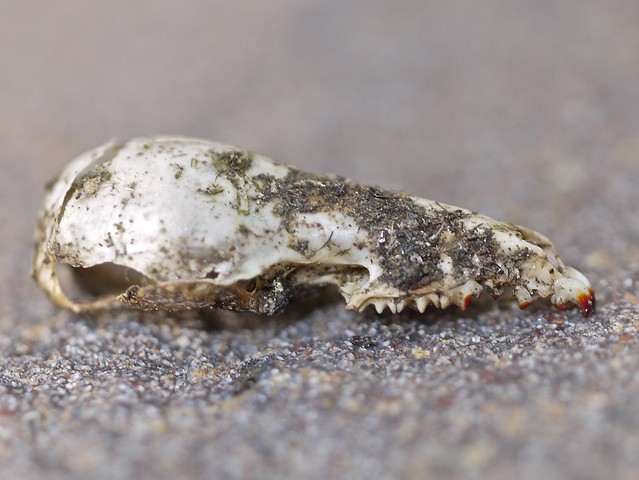
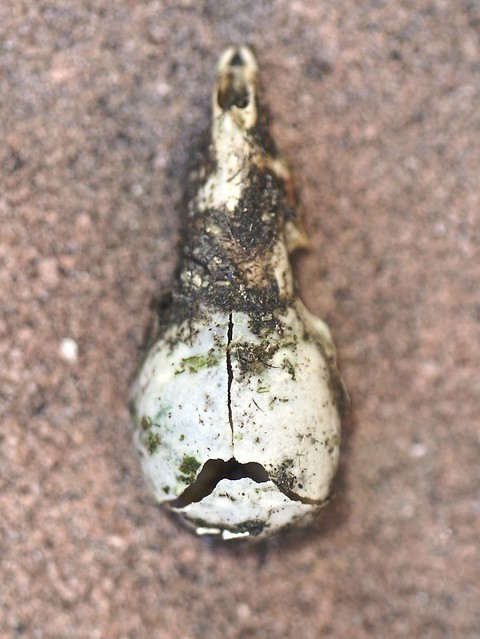
But what species is it?
Unfortunately, the naming of a shrew is no trivial task. Many look alike.
Details such as pelage, range and habitat help, but are often inconclusive. And areas commonly have 2-3 species. As is the case in the Santa Cruz Mountains, where I found this skull. 3 species are likely: Trowbridge's, Sorex trowbridgii, Vagrant, Sorex vagrans, and Ornate, Sorex ornatus.
No - to get to truly definitive IDs, the species keys require a look at the teeth. Meaning you really must have a skull or dead shrew (getting them to grin in-hand or for cam traps is a pain).
The upper incisors hold the first key character to consider. If they show grooves/tines parallel to, and near the inner edges, then the shrew is in the Otisorex subgenus. And of our 3 possibles the only Otisorex is Trowbridge's shrew.
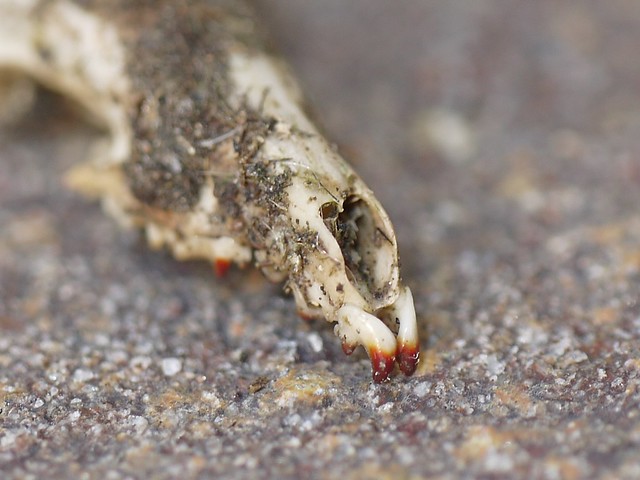
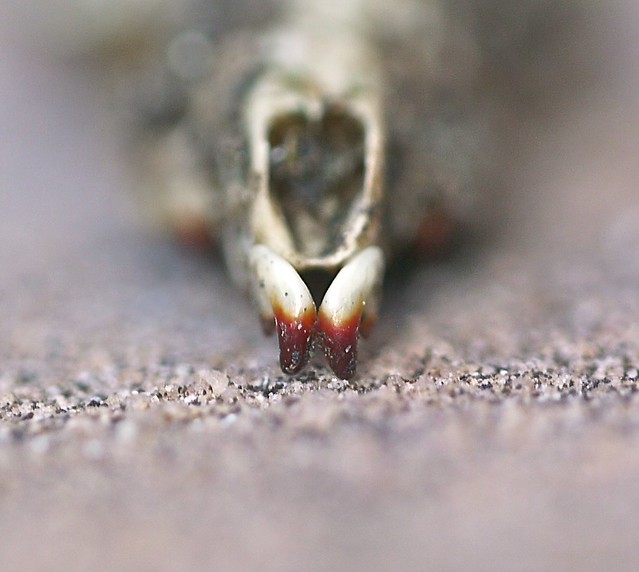
But no median tines are evident. The incisors are nearly smooth.
So, Trowbridge's is out.
The upper unicuspids are the next key teeth. Shrews have 3-5 of them between their incisors and molars, and the number and size can be used to separate species.
In this case, the key question is whether the 3rd unicuspid is obviously smaller than the 4th unicuspid. If so, it's Ornate. If not, then Vagrant (both have 4 unicuspids).
But as you can see, the skull seems to be missing unicuspids:
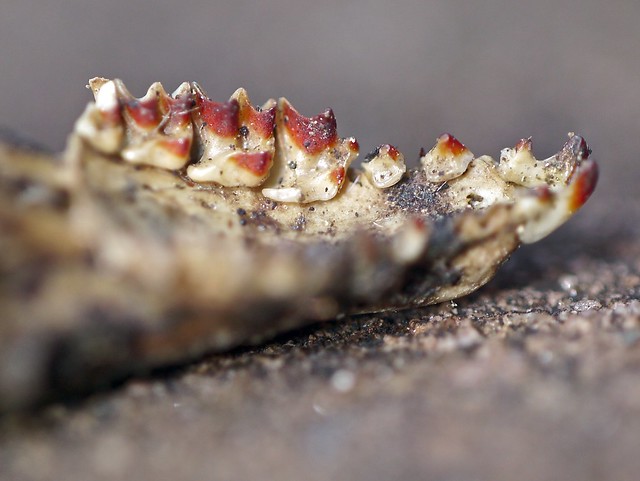
On both sides:

D'oh!
However, when I examine the areas and sockets closely, it does seem plausible the 3rd unicuspid was smaller than the 4th.
Note - the unicuspids give us a second check for Otisorex, and thus Trowbridge's, too. If Otisorex, the unicuspids should have red pigment lines defining and running down their inner ridges. They don't, so that also suggests a Sorex subgenus shrew and not Otisorex.
Btw - I expect some may be wondering about that wild red pigment. It's iron. Gets deposited under the enamel as a hardening agent as the shrew eats/grows. Turning them into iron-toothed buzz-saws. A valuable adaptation for a critter that's biting bug carapaces all the time.
So where does that leave our ID? At likely Ornate, I think. But we're not done - I have more supporting evidence:
Incisor pigment: in Vagrant, the red on the upper incisors usually doesn't extend above the break in the inside curve. And on ours it does.
Skull shape: Ornate have flat skulls, and Vagrant more contoured on top. Comparing the above side shot to reference photos also strongly supports Ornate.
Habitat: Vagrant shrews are widespread and typically live in wet meadows or forests on creeks. The Ornate shrew is a Central Valley and Coast Ranges species found in many habs, including wet meadows, salt marshes, open oak and conifer woodlands, and vernal pool grasslands. The oak woodland where I found the bottle could work for both, but I'd edu-guess Ornate more likely. The SC Mtns are Coast Range after all, and the bottle location was not very close to permanent water (for a shrew). Although 50-ish years ago that may have been a different story.
Final call: probably Sorex ornatus, the Ornate Shrew.
Just in case anyone is still wondering "why the heck is this so dang hard?" - here's a final photo that might help answer that question...
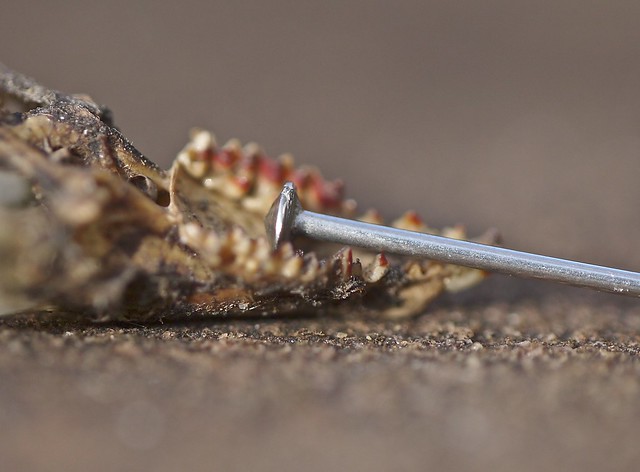
And now you also know how many angels can dance in the mouth of a shrew.
No matter which species.
====
References:
- E.W. Jameson, Jr., and Hans J. Peeters - Mammals of California
- Mark Elbroch - Animal Skulls: A Guide To North American Species
- Camera Trap Codger - posts on shrews
- Wikipedia - Red-toothed Shrews
- Wikipedia - How many angels can dance on the head of a pin?

Fascinating. Truly, and all the while I was asking "why are their teeth brown?" my professors have always joked in the intro class I took, that "shrews chew" to help students ID shrew skulls from other ittie bitties.
ReplyDeleteShrewed workout, man.
ReplyDeleteSMH
DeleteThat was a nicely laid out display of how painstaking id can be. (Of course Codger said it much cleverererer). Nice bottle too.
ReplyDeleteHave you seen this skull app yet? The story behind it (heard on NPR) is amazing too.
ReplyDeletehttp://www.touchpress.com/titles/skulls/
Very cool. Pretty soon well be able to carry fully location-dynamic flora and fauna keys on our iphones. Take a photo of a feather and/or go through quick keys, and voila - species. For flowers, bird song, leaves, skulls, tracks... it's all coming.
DeleteNice one, RT.
DeleteMan...wonder if that skull app would ever come out for Kindle Fire? Doubt it....but there's no way in heck I can afford an iPad (couldn't really even afford the Kindle, but my wife insisted that I needed it for christmas).
Guess I'll have to stick with Elbroch's book (not like that's a bad thing, though :) )
The app looks cool!